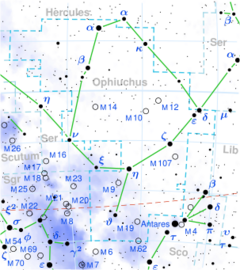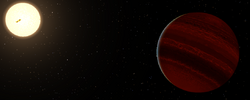Astronomy:Nu Ophiuchi
| Observation data Equinox J2000.0]] (ICRS) | |
|---|---|
| Constellation | Ophiuchus |
| Right ascension | 17h 59m 01.59191s[1] |
| Declination | −09° 46′ 25.0798″[1] |
| Apparent magnitude (V) | +3.332[2] |
| Characteristics | |
| Spectral type | K0 IIIa CN –1[3] |
| U−B color index | +0.873[2] |
| B−V color index | +0.999[2] |
| Astrometry | |
| Radial velocity (Rv) | 12.95 ± 0.41[4] km/s |
| Proper motion (μ) | RA: –9.48[1] mas/yr Dec.: –116.69[1] mas/yr |
| Parallax (π) | 21.64 ± 0.26[1] mas |
| Distance | 151 ± 2 ly (46.2 ± 0.6 pc) |
| Absolute magnitude (MV) | –0.19[5] |
| Details | |
| Mass | 3.04[6] M☉ |
| Radius | 14[4] R☉ |
| Luminosity | 123[6] L☉ |
| Surface gravity (log g) | 2.7[4] cgs |
| Temperature | 4,928[6] K |
| Metallicity [Fe/H] | 0.02[4] dex |
| Rotational velocity (v sin i) | 2.1[4] km/s |
| Age | 330[6] Myr |
| Other designations | |
| Database references | |
| SIMBAD | data |
Nu Ophiuchi (ν Oph, ν Ophiuchi) is a star in the equatorial constellation of Ophiuchus. The apparent visual magnitude is +3.3,[2] making it one of the brighter members of this constellation. Based upon parallax measurements made during the Hipparcos mission, this star is located about 151 light-years (46 parsecs) from Earth.[1]
Properties
Nu Ophiuchi has about three times the mass of the Sun and is roughly 330 million years old.[6] The spectrum of the star matches a stellar classification of K0 IIIa,[3] indicating it is a giant star that has exhausted the supply of hydrogen at its core and evolved away from the main sequence of stars. Unusually, it displays an anomalously low abundance of cyanogen for a star of its type.[3] The star's outer envelope has expanded to around 14[4] times the Sun's radius and now radiates with a luminosity 123[6] times that of the Sun. This energy is emitted from its outer envelope at an effective temperature of 4,928 K,[6] giving it the cool, orange hue of a K-type star.[8]
Companions
This is not a binary star system in the sense of having a gravitationally-bound stellar companion.[9] However, in November 2003, a brown dwarf companion Nu Ophiuchi b was discovered. This sub-stellar companion has at least 21.9 times the mass of Jupiter and takes 536 days (1.47 years) to complete an orbit.[10] A second brown dwarf companion was discovered in 2010, orbiting further from the star with a period of 3,169 days (8.68 years). These have been confirmed in 2012.[6] Two brown dwarfs are locked in 1:6 orbital resonance.[11]
| Companion (in order from star) |
Mass | Semimajor axis (AU) |
Orbital period (days) |
Eccentricity | Inclination | Radius |
|---|---|---|---|---|---|---|
| b | 22.2-81.7 MJ | 1.803 | 530.73±0.10 | 0.124±0.003 | 16-90° | — |
| c | 24.7-92.0 MJ | 6.022 | 3188.95±6.26 | 0.178±0.006 | 16-90° | — |
This star is following an orbit through the galaxy that carries the star between 23.4–29.2 kly (7.2–9.0 kpc) from the Galactic Center. As a probable member of the Milky Way's thin disk population, it has a low orbital inclination that carries it no more than about 100 ly (31 pc) above the galactic plane.[12]
Naming
This star is sometimes called by the name Sinistra, meaning left side in Latin,[13] although authors like Jim Kaler recommend not using this name, and instead stick to the Bayer designation only (Nu Ophiuchi).[14]
In China , the star is part of 天市左垣 (Tiān Shì Zuǒ Yuán), meaning Left Wall of Heavenly Market Enclosure. The stars in this group include ν Ophiuchi, δ Herculis, λ Herculis, μ Herculis, ο Herculis, 112 Herculis, ζ Aquilae, θ1 Serpentis, η Serpentis, ξ Serpentis and η Ophiuchi.[15] Consequently, ν Ophiuchi itself is known as 天市左垣九 (Tiān Shì Zuǒ Yuán jiǔ, English: the Ninth Star of Left Wall of Heavenly Market Enclosure), and together with ζ Capricorni represents the state Yan (燕)[16][17] in the Twelve States constellation.[18]
See also
References
- ↑ 1.0 1.1 1.2 1.3 1.4 1.5 van Leeuwen, F. (November 2007), "Validation of the new Hipparcos reduction", Astronomy and Astrophysics 474 (2): 653–664, doi:10.1051/0004-6361:20078357, Bibcode: 2007A&A...474..653V
- ↑ 2.0 2.1 2.2 2.3 Gutierrez-Moreno, Adelina et al. (1966), "A System of photometric standards", Publications of the Department of Astronomy University of Chile (Publicaciones Universidad de Chile, Department de Astronomy) 1: 1–17, Bibcode: 1966PDAUC...1....1G
- ↑ 3.0 3.1 3.2 Morgan, W. W.; Keenan, P. C. (1973), "Spectral Classification", Annual Review of Astronomy and Astrophysics 11 (1): 29, doi:10.1146/annurev.aa.11.090173.000333, Bibcode: 1973ARA&A..11...29M
- ↑ 4.0 4.1 4.2 4.3 4.4 4.5 Massarotti, Alessandro et al. (January 2008), "Rotational and Radial Velocities for a Sample of 761 HIPPARCOS Giants and the Role of Binarity", The Astronomical Journal 135 (1): 209–231, doi:10.1088/0004-6256/135/1/209, Bibcode: 2008AJ....135..209M
- ↑ Takeda, Yoichi; Sato, Bun'ei; Murata, Daisuke (August 2008), "Stellar parameters and elemental abundances of late-G giants", Publications of the Astronomical Society of Japan 60 (4): 781–802, doi:10.1093/pasj/60.4.781, Bibcode: 2008PASJ...60..781T
- ↑ 6.0 6.1 6.2 6.3 6.4 6.5 6.6 6.7 Sato, Bun'ei et al. (2012). "Substellar Companions to Seven Evolved Intermediate-Mass Stars". Publications of the Astronomical Society of Japan 64 (6): 135. doi:10.1093/pasj/64.6.135. Bibcode: 2012PASJ...64..135S.
- ↑ "nu. Oph". SIMBAD. Centre de données astronomiques de Strasbourg. http://simbad.u-strasbg.fr/simbad/sim-basic?Ident=nu.+Oph.
- ↑ "The Colour of Stars", Australia Telescope, Outreach and Education (Commonwealth Scientific and Industrial Research Organisation), December 21, 2004, http://outreach.atnf.csiro.au/education/senior/astrophysics/photometry_colour.html, retrieved 2012-01-16
- ↑ Eggleton, P. P.; Tokovinin, A. A. (September 2008). "A catalogue of multiplicity among bright stellar systems". Monthly Notices of the Royal Astronomical Society 389 (2): 869–879. doi:10.1111/j.1365-2966.2008.13596.x. Bibcode: 2008MNRAS.389..869E.
- ↑ Mitchell, D. S.; Frink, S.; Quirrenbach, A.; Fischer, D. A.; Marcy, G. W.; Butler, R. P. (2003), "Four Substellar Companions Found Around K Giant Stars", American Astronomical Society Meeting 203 (American Astronomical Society) 203: 1234, Bibcode: 2003AAS...203.1703M
- ↑ 11.0 11.1 Quirrenbach, Andreas; Trifonov, Trifon; Lee, Man Hoi; Reffert, Sabine (2019), "Precise radial velocities of giant stars", Astronomy & Astrophysics 624: A18, doi:10.1051/0004-6361/201834423
- ↑ Soubiran, C. et al. (2008), "Vertical distribution of Galactic disk stars. IV. AMR and AVR from clump giants", Astronomy and Astrophysics 480 (1): 91–101, doi:10.1051/0004-6361:20078788, Bibcode: 2008A&A...480...91S
- ↑ "Sinistra". http://www.constellationsofwords.com/stars/Sinistra.html.
- ↑ Kaler, Jim. "Nu Ophiuchi". http://stars.astro.illinois.edu/sow/nuoph.html.
- ↑ 陳久金 (2005) (in zh), 台灣書房出版有限公司, ISBN 978-986-7332-25-7
- ↑ (in zh) AEEA (Activities of Exhibition and Education in Astronomy) 天文教育資訊網 2006 年 6 月 23 日, http://aeea.nmns.edu.tw/2006/0606/ap060623.html
- ↑ (in zh) English-Chinese Glossary of Chinese Star Regions, Asterisms and Star Name, Hong Kong Space Museum, http://www.lcsd.gov.hk/CE/Museum/Space/Research/StarName/e_research_chinengstarzone_b.htm#HeavenlyMarketEnclosure, retrieved November 23, 2010
- ↑ (in zh) AEEA (Activities of Exhibition and Education in Astronomy) 天文教育資訊網 2006 年 7 月 4 日, http://aeea.nmns.edu.tw/2006/0607/ap060704.html
 |



